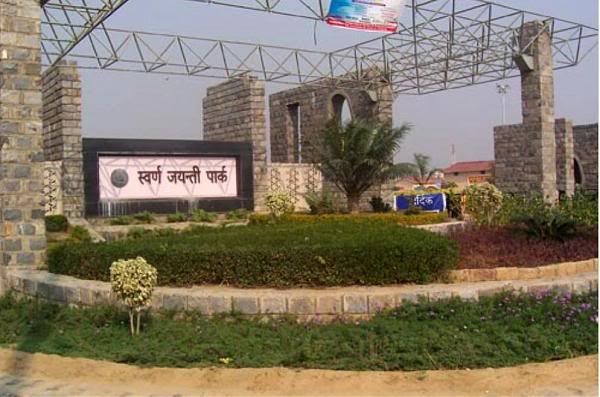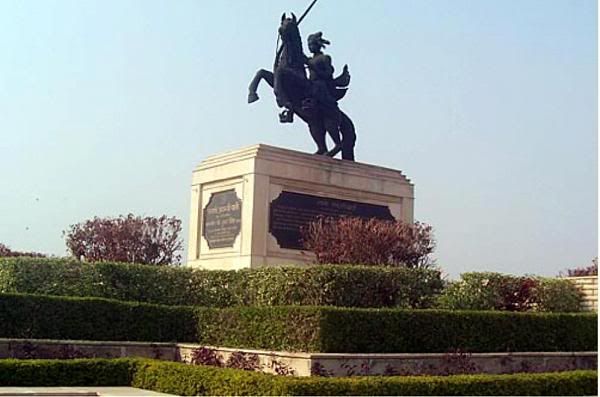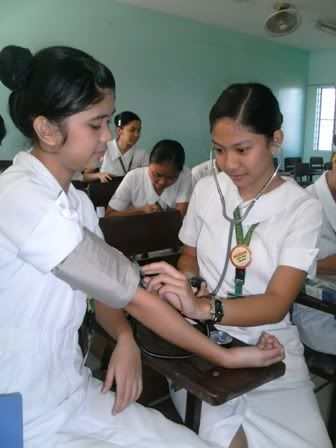- Harish Jharia
Ghaziabad Development Authority (GDA) has made an extremely beautiful huge public park called Swarna Jayanti Park, at Neeti Khand, Indirapuram, Ghaziabad. It is constructed on a 25 acre public land the cost of which might be more than 10 crores Indian Rupees. GDA might have spent another about 25 crores plus on development, construction, installation of status
called Swarna Jayanti Park, at Neeti Khand, Indirapuram, Ghaziabad. It is constructed on a 25 acre public land the cost of which might be more than 10 crores Indian Rupees. GDA might have spent another about 25 crores plus on development, construction, installation of status  and plantation of plants and trees in the park out of the tax payer’s public money.
and plantation of plants and trees in the park out of the tax payer’s public money.

Swarna Jayanti Park is a central place for man, women and children for spending leisure time for getting relaxation and to forget the worries of the struggling hard life that they live in the national capital of India. This place is mainly used by senior citizens for taking morning walks, evening walks and meeting other old age friends to forget the solitary lives that they are forced to live in the dusk of their lives.
for getting relaxation and to forget the worries of the struggling hard life that they live in the national capital of India. This place is mainly used by senior citizens for taking morning walks, evening walks and meeting other old age friends to forget the solitary lives that they are forced to live in the dusk of their lives.

GDA Imposes Entry Fee:
A few months back the people of this place were shocked to learn that GDA has imposed entry-fee on the people who were the sole owners of this park being a public property.
on the people who were the sole owners of this park being a public property.
GDA Imposes Parking Fee:
After another couple of months GDA slapped additional taxation on the people by barricading all the dozen odd parking lots constructed all around the 25 acre park. In addition, they have handed over these parking lots to private parking contractors who are charging parking fees from the people who come to visit this park.
from the people who come to visit this park.
GDA and UP Government are well aware that Swarna Jayanti Park is already earning revenues from the Ghaziabad Hat situated right inside the park. In addition, the government is collecting many other taxes from the residents. The GDA and UP government have many other funds and budget provisions for providing parks and playgrounds for the people of those respective areas.
from the Ghaziabad Hat situated right inside the park. In addition, the government is collecting many other taxes from the residents. The GDA and UP government have many other funds and budget provisions for providing parks and playgrounds for the people of those respective areas.
As such both of these government bodies need not go for imposing additional financial burden on the people who are the taxpayers ; out of the financial contributions of whom, Swarn Jayanti Park has been constructed.
; out of the financial contributions of whom, Swarn Jayanti Park has been constructed.
In view of the above, GDA and UP Government may issue orders to lift all the restrictions, including the entry fees and parking fees, imposed by the concerned authorities on the people for visiting the public park .
.
-------------------------
npad
Ghaziabad Development Authority (GDA) has made an extremely beautiful huge public park

Main Entrance, Swarna Jayanti Park
Swarna Jayanti Park is a central place for man, women and children for spending leisure time

Rani Jhansi Statue, Swarna Jayanti Park
GDA Imposes Entry Fee:
A few months back the people of this place were shocked to learn that GDA has imposed entry-fee
GDA Imposes Parking Fee:
After another couple of months GDA slapped additional taxation on the people by barricading all the dozen odd parking lots constructed all around the 25 acre park. In addition, they have handed over these parking lots to private parking contractors who are charging parking fees
GDA and UP Government are well aware that Swarna Jayanti Park is already earning revenues
As such both of these government bodies need not go for imposing additional financial burden on the people who are the taxpayers
In view of the above, GDA and UP Government may issue orders to lift all the restrictions, including the entry fees and parking fees, imposed by the concerned authorities on the people for visiting the public park
-------------------------
npad



